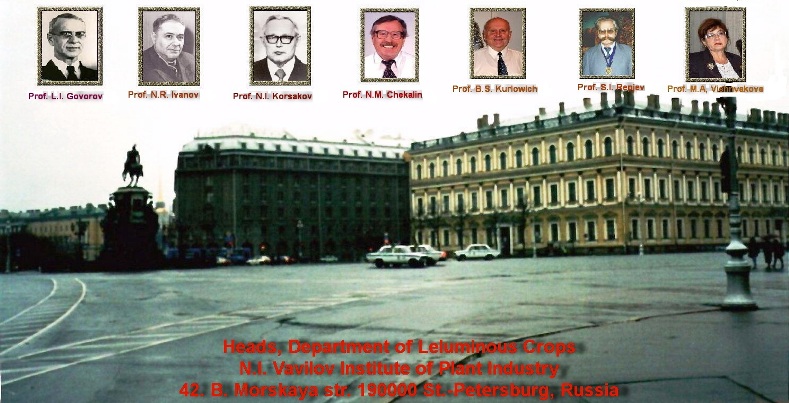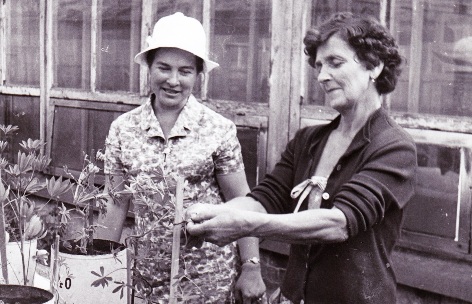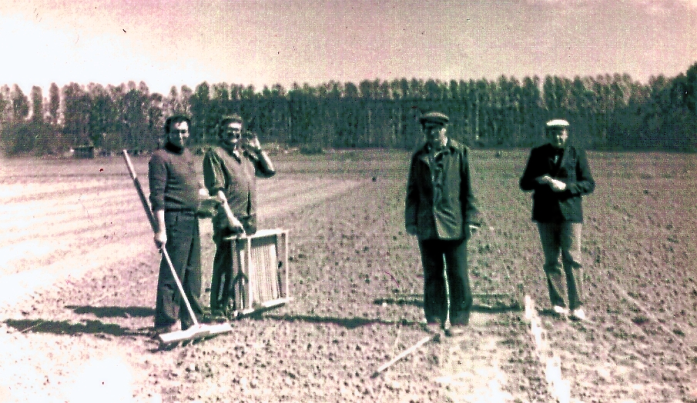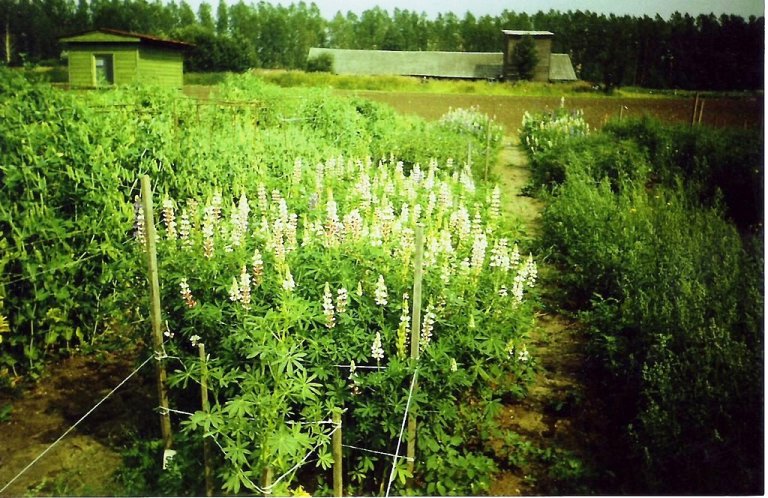|
Site menu
Site friends
Statistics
Total online: 1 Guests: 1 Users: 0 |
Genetic Resources of Leguminous Plants in the N.I. Vavilov Institute of Plant Industry In the centre of St.-Petersburg in
St. Isaac’s Square (B.
Morskaya str. 42-44) two buildings constructed by architect Yefimov are
situated. They house the N.I. Vavilov Institute of Plant Industry. There is a
memorial board on one of these buildings with the following words carved: « Nikolai
Ivanovich VAVILOV, a prominent biologist, worked here in 1921-1940».
Nikolai I. Vavilov (1887–1943) is recognized as the foremost plant geographer, botanist and geneticist of contemporary times. In the early 20th century, the world did not appreciate the urgency of protecting the environment and scientists thought little about the gradual disappearance of valuable plant species. Vavilov was among the first to recognize the need for intensive plant collecting, research and preservation. He organized and took part in over 100 collecting missions in the major agricultural areas of the world. During these expeditions, Vavilov paid special attention to leguminous crops as sources of protein and as means of increasing soil fertility (Sinskaja 1991). He considered these issues to be of the highest priority in biological and agricultural sciences for developing sustainable agricultural production. Many close colleagues of Vavilov e.g. Barulina (his second wife), Govorov, Zhukovsky, Sinskaja further developed his ideas, selecting legumes as the subject of their research.
Govorov, L.I. (1885-1941) Prof. Leonid I. Govorov was the Russian agronomist and
plant breeder; from 1915 worked at Moskow Breeding Station; from 1923 was the
Head of the Steppe Station, and later was the first Head of the Department of Leguminous Crops at VIR.
Vavilov
and his colleagues revealed a number of important findings in plant biology
through such research. However, this vast body of work has not been brought
together in a single report. Vavilov’s
expeditions and their outcomes Vavilov was particularly interested in the sites of ancient
agricultural civilizations and of mountainous regions. In 1916, he was sent to
Iran and Pamir by the Ministry of Agriculture to determine the reasons for
disease epidemics among the resident Russian garrisons. Vavilov discovered that
the wheat used for bread flour was contaminated with seeds of the poisonous
grass species Lolium temulentum.
Vavilov continued his travels in the northern and central regions of Iran, in
Pamir and other regions of Central Asia. His main purpose was to collect early
varieties of agricultural plants for testing in northern and droughty areas of
Russia, and to determine the high-altitude limits of agriculture (Vavilov
1987a, 1991). He was also searching for "Persian wheat”, reported to be
resistant to many diseases (Bazilevskaya and Bakhareva 1991). Despite a careful search, Vavilov did not find
"Persian wheat" in Iran. However, he did collect many other valuable
accessions, among them leguminous crops including mung bean, chickpea, lentil, everlasting pea, pea, beans and species of clover, not known at that time in
Russia. The materials collected by Vavilov in Iran and in Pamir formed the
foundation of the collection of leguminous grain crops of the VIR. As a result
of his first expedition, 171 grain legumes samples were collected. Subsequent
collecting missions of L.I. Govorov, N.R.Ivanov, P.M. Zykovsky, B. S. Kurlovich increased the number of legume accessions from Central
Asia to 1373. The results of a detailed investigation of these were a
starting-point for developing a number of important theoretical and practical
generalizations on the origin, geography, genetics, disease resistance and
evolution of cultivated plants.
Vavilov’s travels in Iran indicated that there
were sources of ancient agriculture in southwest Asia. He also detected
particular ecotypes in Pamir, which suggested their origin was in those
mountains. He concluded that southwestern Asia was a centre of origin of a many
legume species (Vavilov 1965b). The majority of the legumes samples from this
centre were small-seeded with specific flower colours determined by recessive genes
(Zhukovsky 1971). Cross-pollinated species from southwest Asia (everlasting
pea, fodder beans) have a propensity for self-fertilization. In the law of
homologous series (Vavilov 1920), which was largely formulated following the
expedition to Iran and Pamir, Vavilov noted that variability characterized the
entire Leguminosae (Vavilov 1920, 1987b). E.I. Barulina established a precise
parallelism in variability of vetch and lentil samples that originated from
Iran (Barulina 1930). Their similarity is such that even an expert finds it
difficult to distinguish between seeds of these species.  N.I. Vavilov with his wife E.N. Barulina, 1926 (before their expedition to the Mediterranean). This example has become a classic illustration of Vavilov’s law of homologous series in hereditary variability (Sinskaja 1969; Makasheva 1973, 1979; Vavilov 1987a, 1987b). Forms of legumes with various seed and flower colours, obeying the law of homologous series, are demonstrated by many species of lupin, peas, mung bean, string bean and fodder beans. In 1924, Vavilov organized an expedition to Afghanistan together with V.N. Lebedev and D.D. Bukinich (to Herat, Afghan Turkestan, Gaimag, Bamian, Hindu Kush, Ba Kafiristan, Jalalabad, Kabul, Kandahar, Baquia, Helmang, Farakh and Sehistan). The findings from this expedition supported the conclusions about southwest Asia as a centre of origin of many plants. It was established that Afghanistan was a major primary focus of formation where there existed a large diversity of many major Eurasian crops, representing an inexhaustible source of initial material for selection (especially for drought resistance). Following this hazardous and very fruitful expedition to Afghanistan, Vavilov was awarded the N.M. Przevalski Gold Medal of the Russian Geographic Society, of which Vavilov was president from 1931 to 1940.
Vavilov had a special interest in the Khoresm
oasis, whose proximity to Afghanistan and Iran supported the hypothesis that
this territory was also a focus of formation. Vavilov inspected area around the
Amu Darya River (Khiva, Urgench, Gurlen and Tashauz) in 1925. Whereas there
were signs in Iran and Afghanistan that cultivated plants had developed
locally, Khoresm showed signs of connections with northeast Africa and Egypt
that influenced the features of cultivated plants. White-seeded forms of peas,
haricot bean and fodder bean were found in Khoresm, together with particular
forms of groundnuts and alfalfa. Khoresm oasis was characterized by an
abundance of many recessive forms of cultivated plants (Vavilov 1926;
Bazilevskaya and Bakhareva 1991). The
characteristics of the principal legume accessions collected by Vavilov Mung
bean (Vigna radiata (L.) R.Wilczek) Vavilov collected 115 accessions of mung bean
during his first expedition in 1916. Mung bean is an ancient food crop of
southwest Asia. It has a high seed protein content (23.0–32.1%), high lysine,
tryptophane and vitamin contents, and good flavour and cooks quickly (20–40 min).
These properties have made it a favourite food of the local population. Its
foliage is useful as forage for cattle and as a green manure.
Vavilov’s accessions of this crop were studied
at the Central Asian branch of VIR (Popova 1937; Pavlova 1952; Ivanov 1961).
From a detailed study of the assembled diversity of mung bean, G.M. Popova
developed an intraspecific classification of this crop, differentiating three
subspecies: Indian (indicus), Chinese
(chinensis) and Iranian (iranicus). She also described 63
varieties of mung bean (Popova 1937). Subspecies iranicus are characterized by
a twisted form of bush, a stalk height of 86-128 cm, 50-180 pods per plant (7-8
cm long), seeds of various colours (yellow, green, grey, brown) and 1000-seed
weight of 32.8-49.8 g. Most accessions are early maturing, but late-maturing
accessions also exist. The growing period in Central Asia is 91-122 days. The
seed yield per plant ranges between 7.3 and 17.0 g. Two accessions from
Afghanistan (k-2209, k-2216) are highly resistant to drought and are of
particular interest. Accessions of Iranian origin differ by having large
above-ground biomass and are potentially useful for creating cultivars intended
for fodder and green manure.
Chickpea (Cicer arietinum L.) This is an ancient crop of Iran and Central Asia
and is represented by numerous local races with small seeds. Plants are small
and suited only to manual harvesting. However, they are widely used in
breeding. The variety ‘Tadzhiksky 10’
was created by individual selection from Vavilov’s Tadzhikistan samples. It
matures early and is resistant to fusarium wilt. This variety was used to breed
the variety ‘Zimistony’, which is
also characterized by early maturity and high productivity in Tadzhikistan. ‘Milutincky’ was developed from the
Iranian sample k-327 by individual selection for Uzbekistan conditions. This
cultivar is drought and disease resistant. ‘Tashkent
511’ was created from Afghan sample k-223 through mass selection. It has
enhanced protein content and disease resistance. ‘Kubansky 16’ was developed for conditions of the Kuban region from
Uzbek sample k-16. ‘Volga-5’ has shown itself highly productive in central
Russia. It was bred using accession k-249 from Afghanistan.
Vavilov’s lentil accessions are mainly dwarf
forms with small seeds belonging to a large number of varieties: persica,
grisea, violascens and others. There are many endemic forms of early and
semi-early varieties that are drought resistant and have good cooking
properties (Table 3). Pamir sample k-194 matures later than all others (growth
period 86-102 days). Accessions k-5, k-196, k-434, k-435 have light-blue
flowers. Material assembled by Vavilov was used as the basis for creating the
commercial cultivar ‘Tadzhik 95’, which matures early, has good cooking
properties and is drought resistant. ‘Azer’, now cultivated in Azerbaijan, was
created using sample k-373 from northern Afghanistan. It is characteristically
tall and has rhomboid beans. Its growth period is 81-95 days and it has a seed
protein content of 29-30% and a 1000-seed weight of 34-37 g.
Pea (Pisum sativum
L.)Accessions of pea from Pamir have good
winter-hardiness, dark seeds and a specific interaction with Rhizobium
bacteria. Many accessions of Afghan origin do not produce nodules and have low
nitrogen-fixing ability, even when artificially inoculated with Rhizobium. This
feature is widely used for control and matching in genetic research. New
varieties of peas with enhanced biological nitrogen-fixing ability have been
bred from this material (Tchetkova and Tikhonovich 1986). Currently there is
considerable interest in genetic studies of multimarker lines containing the
sym-locus from a non-nodulating gene of Afghan origin.
Pea lines under the common name Mushung (k-181,
k-182, k-184 and k-190) were the basis of the commercial cultivar of winter
peas ‘Mushung mestny’, which was extensively cultivated in Tadzhikistan.
‘Wostok 55’ was bred for Uzbekistan conditions.
Lupin (Lupinus albus
L.)Valuable accessions of white lupin were
collected by Vavilov during his trip to the Mediterranean in 1926 (Table 4). In
Palestine, he identified very early, thermally neutral and small-seeded forms
of the Jordanian ecotype. In particular, the sample Tel Karam k-290 has a
growth period in Ukraine of only 105 days. In contrast, lupin accessions from
Sudan are very late, but highly productive and large-seeded (k-486, k-495).
Samples of the Jordanian ecotype from Palestine have special value as source
material for lupins bred for Russian, Polish and Ukrainian conditions. Their
use in hybridization with lines of the Georgian ecotype, following mutagenesis,
allowed V.I. Golovchenko to create early and highly productive cultivars,
‘Kievsky mutant’, ‘Horizont’ and ‘Druzba’ for Russia and the Ukraine
(Golovchenko et al. 1984).
Doctor Sofia
I.Stepanova and assistant Elena I. Kazanskaya
study the accessions of white lupin collected by Nikolay Vavilov Vavilov not only collected and organized research on the assembled material, but also attempted to establish new methodologies. He was particularly keen to develop simpler and more accessible methods for determining alkaloid content in lupin. This was important in 1928-1929 as von Sengbusch, in Germany, had developed such a method but it was kept secret and the sweet strains of lupin were sold to a private firm. Under the management of N.N. Ivanov, and further elaborated by M. I. Smirnova and others, an efficient expression method was developed and adopted in VIR. In 1932, Vavilov wrote the foreword to a work by Ivanov et al. (1932) that was central to the initiation of breeding fodder (sweet) low alkaloid lupin. Vavilov worked on global genetic diversity of
cultivated plants throughout his life, from which he developed several major
theories that have played an important role in the development of botany,
genetics and plant breeding. Cornerstones of this work include the law of
homologous series in hereditary variability, studies on the problem of
speciation, differential systematic-geographical methods for studying crops,
botanical and geographical aspects of plant breeding, and the theory of the
centres of origin of cultivated plants (Vavilov 1920, 1926, 1935, 1940, 1997).
Centres of origin Vavilov’s theory of introduction was based on his
understanding of the nature of variation of the earth’s vegetation, having
identified a number of areas characterized by particular diversity and richness
of species and types (Vavilov 1965b). More than 70 years ago Vavilov selected
five ancient foci for the origin of cultivated plants from local flora (Vavilov
1926). Subsequently (Vavilov 1935), he introduced methods for better determining
these foci and identified six foci and two centres of origin of cultivated
plants. Vavilov constantly developed and deepened his main thoughts in
subsequent publications. He eventually settled on seven primary centres of
diversity: Tropical, East Asiatic, Southwest Asiatic, Mediterranean,
Abyssinian, Central American and Andean (Vavilov 1940, 1962, 1987a, 1997) (Fig.
2). He also established specific foci for some of these centres. The localization of centres and foci of origin
of cultivated plants has been further developed by Sinskaja (1969) and
Zhukovsky (1971) in Russia and by scientists from many other countries.
Sinskaja (1969) revealed broader geographical connections and mutual
interaction of floras. She distinguished five principal areas and updated the
list of cultivated crops in each. Zhukovsky (1971) accepted Vavilov’s
definition of centres of diversity but increased the number to 12 and renamed
them gene-centres. In our opinion (Kurlovich 1998), there are centres of
formation for wild species, where they originated after the last ice-age, and
also centres of origin (diversity) for cultivated plants, where these plants
were domesticated.
Vavilov has received considerable support for
his determination of centres of diversity (Kurth 1957; Harris 1967; Harlan
1971; Brezhnev and Korovina 1981; Mathon 1981). However, some critics believe
that it is very difficult to determine the initial geographical origin of
species and prefer the term "centres of diversity” instead of Vavilov’s
"centres of origin”. Pistorius (1997) considers the term "centres of diversity”
safer. Even in a modified form, Vavilov’s theory of centres is used as a
theoretical basis for collecting, studying and using genetic resources of
cultivated plants.
Vavilov considered the Mediterranean region and
mountainous areas of Mexico and the Andes to be centres of origin of the genus
Lupinus (Vavilov 1926). This has allowed more precise determination of the
centres of formation and origin (diversity) for specific lupin species (L.
albus L., L. luteus L. and L. angustifolius L.). Our data (Kurlovich 1989),
however, indicate that the centre of formation of wild white lupin (L. albus
L.) and the primary centre of origin (diversity) of its initial cultivated
forms is the Balkans, where there exists a wide diversity of wild, feral and
local forms. All three white lupin subspecies (graecus, termis and albus) are
grown in the Balkans. Wild forms with dotted dark brown seeds and dark blue
flowers are found there. The centres of diversity of cultivated white lupins
include the Apennines and Egypt, where cultivated forms of white lupin
originated in ancient times. In Egypt, forms with pink-and-blue or light pink
flowers exist; in the Apennines, there are forms with greyish-and-light blue or
white flowers.
Two close Lupinus species exist in the Pyrenees
(L. luteus L. and L. hispanicus Boiss. et Reut.). They have the same number of
chromosomes (2n=52) and there is a wide diversity of wild and cultivated forms
of yellow lupin (L. luteus L.) and a long historical record of their growing
there. This indicates that the Pyrenees was a centre of formation of the wild
forms of yellow lupin (L. luteus L.) and the centre of diversity of cultivated
plants (Kurlovich 1998). For similar reasons, we consider the Pyrenees to be a
centre of diversity for narrow-leafed lupin (L. angustifolius L.).
The agricultural area devoted to lupins has
gradually increased as a result of varietal development. Consequently,
secondary macro and micro centres of diversity of cultivated forms have
developed on different continents. These correspond to many geotypes and
ecotypes described by Kurlovich (1998). Secondary centres of diversity of
cultivated white lupin occur in Belarus, Chile, France, Germany, Poland and
Russia. Secondary centres of diversity of blue lupin exist in Australia,
Belarus, Poland South Africa and southeastern USA. Secondary centres of
diversity of yellow lupin occur in Belarus, Germany, Poland, Russia and
Ukraine. Results of these studies make it possible, to a certain extent, to
provide answers to the most important questions of plant introduction and
breeding regarding the type and location of material that should be collected
and the purpose to which it should be put.
Vavilov’s law of homologous series When studied under different geographical
conditions, any plant species segregates into a wide range of hereditary forms,
which is initially difficult to understand. However, according Vavilov’s law of
homologous series in hereditary variability, intraspecific diversity does have
some regularity. The essence of the law is that closely related species and
genera are characterized by similar series of variation. Knowing the nature of
succession of varieties in one species, one can forecast the existence of
similar forms in other species and genera. Whole plant families in general are
characterized by a definite cycle of variability, which exists similarly in all
genera and species of that family.
Vavilov described variability in the Fabaceae
(Leguminosae) and established regularity in its differentiation in separate
genera and cultivars, by monitoring characters of seeds, fruits, and flowers,
and vegetative organs. He analyzed variability of characters in accessions of
Vicieae, Trifolieae, Loteae, Galegeae and Phaseoleae (Vavilov 1920; 1987b). It
became clear that, despite differences between these sections, the variability
of characters was similar for all genera within a given family. The genus
Lupinus is more variable than any other genus of the Fabaceae and illustrates
Vavilov’s law of homologous series in hereditary variability (Maissurjan and
Atabekova 1974, Kurlovich et al. 1995). The law of homologous series in
hereditary variability indicates which material should be sought and underlies
the theory for the centres of origin of cultivated plants. It also indicates
where such centres should be located.
Differential systematic-geographical methods Vavilov and his followers used a differential
systematic-geographical method to study intraspecific diversity and to determine
the centres of origin of cultivated plants (Vavilov 1931). This method
consisted of the following:
- differentiation of a genus into species and
intraspecific diversity using morphological, hybridisation, cytological and
other characters
- determination of the genotypical composition
of a species
- geographical localization of hereditary forms
of a species and the centres of their diversity
The large body of theoretical and practical work
involved in these studies allowed Vavilov to comment on the nature and role of
species as a system (Vavilov 1931, 1965a). Previously the prevailing ideas were
those of Komarov (1931, 1944), based on monotypic species, according to which
species cannot include a systematic unit of a lower rank. The concept of a
biological species based on no crossing between species was also widely
accepted (Grant 1981, 1984). Vavilov, however, in a study of several hundred
species showed the absence of monotypic species, i.e. species represented by a
sole race or form. All the species studied appeared to incorporate a number of
forms (genotypes). He considered a species to be a flexible, isolated, complex,
morphophysiological system linked to a particular environment and area (Vavilov
1931, 1965a). This led to the understanding of the Linnaean species concept, an
integral entity consisting of closely interlinked components where the whole
and the parts are merged (Vavilov 1965a; Agaev 1987; Korovona 1987).
Geographical
and ecological differentiationVavilov not only paid attention to morphological
traits, but also took into account geographical and ecological differentiation
of plants. Such an approach based on development of various intraspecific
classifications allowed detailed study of intraspecific and varietal diversity
of cultivated plants, and developments for their effective use. In the
international code for botanical nomenclature there exist fixed categories for
intraspecific classification, including subspecies, varieties, sub-varieties
and forms.
Vavilov paid particular attention to
ecogeographical differentiation of a species into ecotypes, genotypes,
concultivars etc. (Vavilov 1931, 1965a). For classification purposes, VIR’s
scientists routinely use anatomical, cytological, paleobotanical, ontogenetic,
biochemical, physiological, geographical, genetic and other criteria in
addition to the more usual traits. Such a comprehensive approach is
particularly effective for the study of intraspecific diversity in cultivated
leguminous crops. Vavilov’s theories are all interconnected and represent a
complex doctrine about global genetic diversity of cultivated plants. They have
allowed scientists from VIR to develop intraspecific classifications for
practically all leguminous crops, particularly peas (Govorov 1937; Makasheva
1979), mung bean (Popova 1937), soya bean (Korsakov 1971; Teplyakova 1997),
lupin (Kurlovich and Stankevich 1990), chickpea (Seferova 1997) and vetch.
Vavilov’s work in collecting and studying genetic resources of leguminous plants has been continued by VIR scientists. The department of leguminous crops of VIR was established in 1924. Vavilov invited his friend L.I. Govorov to manage the department, and he recruited experts in leguminous plants to the staff. Govorov developed intraspecific classification for peas (Govorov 1937), organized breeding work with leguminous crops in the former USSR and created many pea cultivars. Like Vavilov, Govorov had a tragic destiny; he was arrested and disappeared. P.M. Zhukovsky was invited to manage the lupin collection. He developed and published important works on interspecific and intraspecific diversity (Zhukovsky 1929). Research on the genetic resources of lentil was done by E.I. Barulina (Vavilov’s wife). She took part in many expeditions, e.g. to Crimea, Georgia and other regions (Barulina 1930). During the Second World War the department of leguminous crops was managed by N.R. Ivanov, who made a substantial contribution to preserving the collection during the seige of Leningrad.  Ivanov, N.R. (1902-1978) Prof. N,R. Ivanov was the Russian plant scientist and plant breeder; from 1926 worked at the institute of Applied Botany, was the Institute's Director during the siege of Leningrad; from 1967 was the Scientific Secretary of the Commission on N.I.Vavilov's Heritage under the USSR Academy of Sciens; Vavilov's prize winner. He carried out important research on the genetic resources of kidney bean (Ivanov 1961). After the Second World War, under the direction of Korsakov, ecological and geographical research at VIR was modified and databases on genetic resources were created.
Korsakov,
N.I.
Korsakov also contributed to the clarification of centres of origin of various soya bean species (Korsakov 1971). Currently, VIR has 43 000 accessions belonging to 15 genera and 160 species of the Fabaceae, including pea, soya bean, vetch, lupin, faba bean, lentil, everlasting pea, chickpea, cowpea, mung bean and kidney bean. The collection contains genetic resources from five continents, but most of the accessions were collected from the former USSR and Europe. The staff of the department of leguminous crops selects new, valuable lines, works out advanced methods for breeding and performs research on taxonomy and evolution. Considerable effort is directed at evaluating agronomic traits, including yield factors and tolerance of biotic and abiotic stresses, and at ecogeographic research in various regions of Russia. Researchers
of Leguminous crops department sowing the collection on the experimental field
near the city Pushkin
Collection
of Leguminous Plants on the experimental field near the city Pushkin
Doctor
of agricultural science Rausa Ch.
Makasheva
This interesting phenomenon was commented on by
Ride (1992), in which the author summarized what was known about the
recognition and response mechanisms of higher plants to fungi. Study of the
specific incompatibility between races of pathogens and certain host cultivars has
allowed rapid progress to be made in understanding the mechanism underlying
successful infection (compatibility) and resistance (incompatibility).
Meeting of VIR scientists
Conclusions
The list of references is presented at the end of following article!
|








